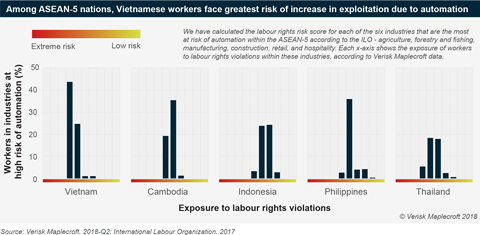More than 55% of jobs in SE Asia’s key manufacturing hubs under threat with slavery and labour abuses in SE Asia set to spiral over next two decades as automation consumes job market
Drastic job losses in South East Asia resulting from the onset of robot manufacturing are predicted to produce a spike in slavery and labour abuses in global supply chains unless governments take early measures to prevent automation threating millions of livelihoods, according to a new report by risk analysis company Verisk Maplecroft.
Automation tops a list of five issues in the annual Human Rights Outlook, produced by Verisk Maplecroft, which are identified as presenting significant challenges to the reputations, operations and supply chains of multinational companies now and in the future.
56% of jobs in SE Asia’s key manufacturing hubs under threat
With the UN’s International Labour Organization (ILO) estimating that over the next two decades 56% of workers in the manufacturing hubs of Cambodia, Indonesia, Thailand, the Philippines and Vietnam will lose their jobs due to automation, the risk of slavery and trafficking appearing in supply chains will spiral, says the report.
This grouping of countries, known as the ASEAN-5, are particularly at risk due to the dependence of the workforce on low-skilled jobs and existing high levels of labour rights violations. All are currently rated as ‘high risk’ countries in Verisk Maplecroft’s Modern Slavery Index, but their rankings and scores are forecast to deteriorate when the full impact of automation is felt.
The report stresses that South East Asia’s manufacturing hubs will not be alone in facing the challenges posed by automation. But, the analysis singles out the region due to its importance to the global supply chains of multinational companies operating in the consumer goods, retail, hospitality and ICT sectors.
“Displaced workers without the skills to adapt or the cushion of social security will have to compete for a diminishing supply of low-paid, low-skilled work in what will likely be an increasingly exploitative environment,” says Verisk Maplecroft’s Head of Human Rights, Dr Alexandra Channer. “Without concrete measures from governments to adapt and educate future generations to function alongside machines, it could be a race to the bottom for many workers.”
Agriculture, manufacturing, retail and hospitality among highest risk sectors
To investigate how automation will impact supply chain workers, Verisk Maplecroft applied its industry-specific labour risk indices to the ILO data across 21 sectors where jobs are at high risk of replacement by automation. The industries where the risk is highest are identified as agriculture, forestry and fishing, manufacturing, construction, retail and hospitality.

The figure above shows the degree to which workers in the ASEAN-5, whose roles are at high risk of automation, are already exposed to labour rights violations.
Vietnam is flagged as the highest risk of the five countries studied, where 67% of workers – 36 million people – will be seeking alternative livelihoods in an environment where the risk of exploitation is already high.
Given the baseline of exploitation across the ASEAN-5 and the numbers of workers affected, the report concludes that the risk of slavery and trafficking will likely rise significantly.
Women disproportionately affected in the garment, textile and footwear industry
Verisk Maplecroft flags the garment, textile and footwear (GTF) industry as being at particular risk from automation within the ASEAN-5. GTF employs 59% of all manufacturing workers in Cambodia and 39% in Vietnam. Any job displacement from this sector will therefore impact a large proportion of the entire manufacturing workforce, the majority of whom are women.
In both Vietnam and Cambodia, over 85% of GTF jobs are at high risk of automation, and over 76% of these jobs are held by women. That means roughly 2.6 million Vietnamese women and over 600,000 Cambodian women will lose their jobs and compete for work in an industry already exposed to a high risk of labour violations. With fewer women in work – or more women forced into slavery – these countries will also struggle to achieve their UN Sustainable Development Goals (SDGs) on gender equality.
“The adoption of automation technologies by companies will be gradual, but the unintended consequences for millions of workers in brand supply chains is likely to be severe,” continues Channer. “Responsible sourcing departments, in particular, need to identify and understand the adverse effects of automation on human rights, and work with civil society and governments to mitigate the impacts within their own supply chains.”





















No comments yet